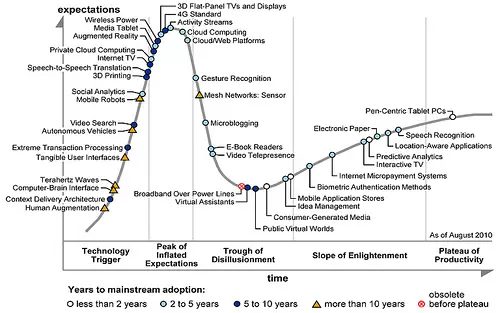Eye on HR: What next for an era-defining tech?
UNLEASH outgoing editor Jon Kennard wraps up his time with a final post that looks at the secondary effects of everyone’s favorite new technology.
Expert Insight
Does the future look bright for an AI-integrated workplace?
Only if you put your money where you mouth is and invest in the right soft skills, UNLEASH editor Jon Kennard.
I do love a graph. For me, there is none more beautiful than the unique undulation of the Gartner Hype Cycle.
While it seems a little odd to be using an emerging technologies sentiment analysis tool such as the Gartner Hype Cycle to analyze AI technology that, in its foundational form is decades old, but for the purposes of my final UNLEASH Op-Ed, I’m going for it.
In AI’s defense, ‘artificial intelligence’ is a rather homogeneous and inexact term now, such is its utility and application split in so many different directions.
A question: is ChatGPT, and generative AI more broadly, at the ‘Peak of Inflated Expectations’, in the ‘Trough of Disillusionment’, on the ‘Slope of Enlightenment’, or resting happily on the ‘Plateau of Productivity’? You would imagine it’s somewhere between the start of the curve, ‘the Innovation Trigger’, and the Peak of Inflated Expectations, seeing as the myriad breathless think pieces (from this digital periodical included) show no signs of abating.
The expected slide into disillusionment will begin to gather pace and bite once regulation is enacted both in the EU and in America too. I know that many innovators decry regulation for obvious reasons.
But, when you have the CEO of the company that produced the two biggest AI game changers of recent times touring the world, telling any government mandarin that will listen that the tech that they themselves developed could destroy the world? Well, it’s probably time to sit up and listen.
Once regulation is rolled out and embedded, a global charter of engagement agreed upon, and agreed guardrails of some description put in place will we see generative AI get back on the slope of enlightenment.
After that, the so-called ‘Plateau of Productivity’ awaits, and then will we truly see AI assistants start to positively affect workflow across organizations and industries at scale.

Copyright Gartner
This year, at UNLEASH America the conversation rarely deviated from AI – on the tech side at least.
From the mainstage to the expo, and up and down the corridors of CAESAR’S FORUM, there were a few very clear topics of conversation among tech vendors, of which AI was the most prominent.
Among the vendor community, it’s natural to talk about the opportunity that it provides. Among HR leaders it’s imperative to maximize productivity, optimize your headcount, and stake your claim as the most important function in the business – all of which AI can help enable.
If you’re a rank and file employee, it’s understandable to be terrified by what an AI-integrated workplace means for your long term job prospects, despite what the proponents of AI tell you.
These are all equally valid viewpoints. But the way I see it, with the experience I have, – and I tend to err on the side of positivity – I do think there will be some near-term instability, before we get to a place where AI can provide the utility that everyone needs it to.
But if we are to make the most of AI and the incredible potential of generative AI, we need to understand some of its second order effects.
These have nothing to do with artificial intelligence as a technology, but are ultimately wrapped up the side effects of its proliferation, namely the critical need to upskill the global workforce in soft skills; curiosity, creativity, teamwork, time management…the more human side of modern business life.
So – the question is: Are we actually doing this? How has soft skills training spending changed in business over the last two years and how do people predict it will change?
According to a study of more than 2,000 UK workers, “51% missed out on essential soft skills building opportunities, with an average cost of £680 each. Projected across the broader population, the cost of not providing these opportunities equates to £22.2bn a year.” More on that story here.
Or would you rather buy into this? Apparently the soft skills training market will grow by $119Bn from 2022-2027.
If leaders ARE genuine about the need to upskill and reskill their people, to offset the potential job losses that AI could drive then we need to invest more, much more, in soft skills. Are businesses actually doing this? And if they aren’t, are they prepared to do it in the future? That, in my opinion is the biggest question around the future of artificial intelligence.
If we see spending around these human skills increasing, this is proof that there’s a bright future for more than one kind of hybrid work.
Sign up to the UNLEASH Newsletter
Get the Editor’s picks of the week delivered straight to your inbox!

Editorial content manager
Jon has 20 years' experience in digital journalism and more than a decade in L&D and HR publishing.
Contact Us
"*" indicates required fields
Partner with UNLEASH
"*" indicates required fields